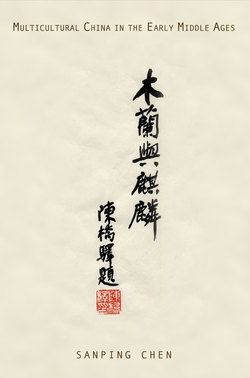Читать книгу Multicultural China in the Early Middle Ages - Sanping Chen - Страница 7
ОглавлениеForeword
Old Wine in New Bottles
Victor H. Mair
After nearly half a century of isolation, China has recently reemerged as an integral member of the global economy and the international political structure. Since its rise has been so explosive, however, knowledge of Chinese culture and society in other countries is still sketchy and often highly distorted. Indeed, so long and so extraordinarily complicated is the Chinese historical record, and so richly complex is Chinese literature, that modern Chinese citizens themselves are often confused about many details of their nation's past.
Virtually everyone has heard of the brave heroine Mulan, who rides off to war (as in the Disney movie), and most of us are familiar with the mythical unicorn that heralds the coming of a sage who will rule justly, yet we see them through a glass darkly. The wonder of this book, Multicultural China in the Early Middle Ages, is that it offers a completely new look at many aspects of Chinese history and culture that heretofore may have seemed bewildering or even absurd.
The author of the present volume, Sanping Chen, has the great virtue of being able to examine the past with a fresh eye. He does not take any received text or tradition at face value. Instead, he closely reexamines all the available evidence and subjects secondary interpretations to intense, critical scrutiny. The results of this type of inquiry are frequently surprising and in many cases revelatory. Yet Dr. Chen is not an iconoclast purely for the sake of iconoclasm. Instead, his goal is simply to penetrate the countless layers of obscurity and misrepresentation to get at the truth of what really happened in the past. More than any other Chinese historian that I know of, Sanping Chen is determined to confront historical data directly and without any presuppositions or agenda whatsoever.
From lengthy, ongoing discussions with Dr. Chen over the years, I have come to realize that his unusual approach to Chinese history results from deeply held principles. Among these the most important is that the historian is duty bound to report his findings, regardless of their implications. A corollary of this principle is that the historian may not lie about or color what he discovers concerning the past. For Dr. Chen, this becomes a moral imperative, such that he cannot remain silent when confronted with the facts of history.
Although Dr. Chen not infrequently mentions the prehistoric period (Neolithic, Bronze Age, and early Iron Age), the early period (the classical era or era of antiquity), and the late imperial period, his main focus is on the medieval period (roughly the first millennium AD). Many events that were profoundly formative for the future of East Asian civilization occurred during this period: the advent of Buddhism, the rise of Taoism as a religion, the first stirrings of the written vernacular, the perfection of literary genres, the incorporation into the Chinese body politic of non-Sinitic peoples in all directions, and so forth. Despite the crucial role this period played in the development of East Asian history, it is relatively little studied and, in general, poorly known, whether by specialists or by laypersons. This is particularly so for the first half of the period, and it is precisely that stretch of five or six hundred years upon which Dr. Chen places his greatest emphasis.
What, then, are a few of Dr. Chen's astonishing discoveries that he presents in this book?
1. Mulan was not Chinese.
2. The East Asian “unicorn” was very different, both in appearance and in significance, from the one-horned creature of Western imagination.
3. The royal house of the Tang Dynasty, which constituted the apogee of premodern Chinese civilization, was in large measure “barbaric.”
4. Despite general Chinese dislike for dogs, canine imagery and terminology have been positively utilized among certain significant groups in East Asia.
5. Both the Huns and the Bulgars have their congeners in East Asia.
6. Iranian peoples were prominent in trade, religion, and other noteworthy aspects of medieval Chinese society.
7. Naming practices changed dramatically in response to influences from the Steppe.
8. One of China's most revered poets, Bai Juyi, had intimate connections with Central Asia.
Sanping Chen's ability to make, and to firmly document, these remarkable discoveries is due to his open-mindedness and insightfulness, but above all to his persistent inquisitiveness. While not everyone will acquiesce to the entirety of Dr. Chen's findings, no reputable scholar can afford to ignore them with impunity.
Dr. Chen's expositions of his discoveries are captivating in and of themselves. When combined with the solid content that they convey, his chapters make for compelling reading. Above all, these are not mere exercises in the realignment of exotic, alien arcana. Rather, everything that Dr. Chen writes about in this inspiring work has profound implications for our understanding of the present, which is a product of the cumulative past. We are greatly in Sanping Chen's debt for his sustained researches as well as for the creative clarity of his vision.
